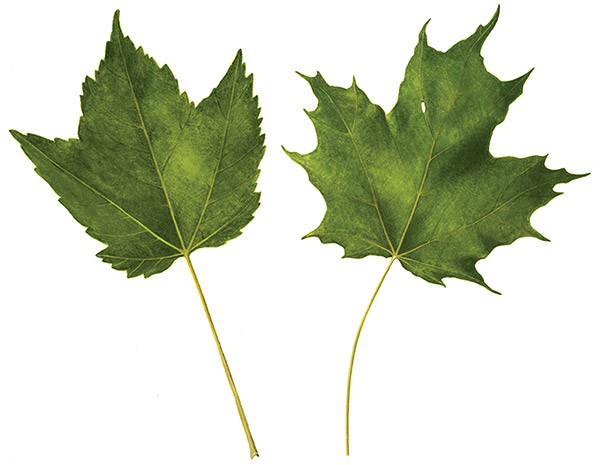There you are, leaning against a big maple in your sugarbush, drill and tap at the ready, when you think, “Wait a minute…is this a red maple or a sugar maple?”
While maples in general are quite easy to distinguish from other forest trees (their twigs and buds grow opposite one another, unlike any other common trees except the ashes, whose twigs are fat and blunt so that they look more like fingers than twigs), telling red maple from sugar maple can vex even seasoned botanists on occasion.
Mid-summer is the easiest time to tell red from sugar, assuming you can clearly see some leaves from the ground. The leaf margins tell the main story: sugar maples have smooth edges while red maples are toothed or serrated. The three lobes of a sugar maple’s leaf are separated by smooth, U-shaped valleys – think U as in sUgar. The red maple’s lobes, meanwhile, are separated by serrated, V-shaped valleys. Overall, this makes the sugar maple’s leaves broader and more rounded than the narrower, pointier leaves of the red.
But if you don’t have leaves, which you don’t for much of the year, including sugaring season, spring is the best time for getting started. If you can hone your skills now, you’ll be much better prepared for the trying days of mid-winter. Red maples are distinctly red in all but their outer bark, though young bark on saplings or branches of red maples does have a burgundy cast to it, almost as if someone had sprayed a gray coat of paint atop a burgundy primer. The buds are also red, as are the stems that support the flowers and samaras.
Sugar maple, by contrast, is golden brown – a honey-colored or medium amber hue that’s very apparent on the buds and flower stems. Indeed, if you see these two species growing side by side from across a field, the effect on a sunny spring day is so pronounced – burgundy versus honey – that you’ll wonder how you ever failed to tell these maples apart.
The shape of the buds is also distinct. Red maple’s are short and knobby, almost like buttons that someone sewed to the end of every branch. Sugar’s are sleek and pointy, shaped more like bullets than buttons. Red buds also stick out nearly perpendicular from the branch, or usually do, compared with sugar’s, which are reliably fixed at about 45 degrees from the branch.
This pattern carries over into the geometry of young branchlets. Red’s often grow 90 degrees out from the main branches, sugar’s at more like 45 degrees. Looking up into the crown of a mature maple, this effect can also be very distinct. The buttony buds of the red maple clearly show on the ends of the perpendicular branchlets. The sleek buds of the sugar maple often can’t be seen at all, lying as they do much closer to the narrow angle of the 45-degree branchlets. If you’re still not sure which maple you’re looking up into, it’s probably a sugar, because the red’s buds and branches are easier to identify.
Which brings us to bark, the characteristic that’s easiest to see from ground level and the one most likely to be inconclusive. The red maple’s bark comes in a wide variety of textures, including one that can only be described as “sugar maple.”
Bark on a mature sugar maple is irregularly furrowed and ropey. It’s rough without displaying any overall pattern or symmetry. It often has a touch of chalky grayness, like young sugar maple saplings.
Red maple bark, if it varies from this at all, has a darker gray cast to it, with occasional dinner-plate-sized smooth patches that stand out, with some of these smooth patches having parallel vertical cracks that look a bit like bear scratches. If you see a round pattern of bark fissures that reminds you of a target, look no farther: it’s a red maple. At other times, however, mature red maple bark can appear shaggy like hophornbeam, really shaggy like shagbark hickory, or crusty like an elderly yellow birch. If the bark makes you think it’s not a maple, but the pattern of opposite branching shows that it is, you’re likely dealing with a red maple.



Discussion *